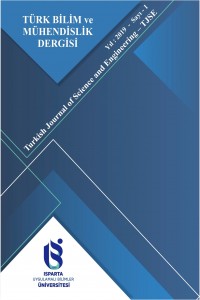Abstract
Bu çalışmada; Anaç adayı olabilecek bazı kabak ve kavun türleri üzerine
Beith Alfa tipi hıyar aşılanmasıyla bu kombinasyonlardan elde edilen aşılı
hıyarların bitki büyümesi, verim ve kalite üzerine etkileri incelenmiştir. Çalışmada; Lagenaria siceraria, Cucurbita
maxima, Cucurbita moshata, Luffa cylindrica, Cucumis melo var.dudaim ve
ticari olarak daha çok karpuz için kullanılan TZ148 F1 anaç olarak, kalem olarak da Bereket F1 hıyar
çeşidi kullanılmıştır. Kontrol grubu olarak aşısız aşısız ve kendi üzerine
aşılı bitkiler kullanılmıştır. Araştırma sonuçlarına göre, bitki boyu
bakımından en yüksek değeri TZ 148 F1 anacı üzerine aşılı hıyar bitkisinden elde
edilirken, yine erkenci verimde en yüksek değer TZ 148 F1 anaçlarından elde edilmiştir. Toplam verimde
aşısız (kontrol) grubu, kendi üzerine aşılı (Bereket F1/ Bereket F1) ve TZ 148 F1 üzerine aşılı olan kombinasyonların verimleri
daha yüksek olarak belirlenmiştir. Bu çalışmanın sonunda uygun anaç
kombinasyonunun belirlenmesi ile denemede kullanılan hıyar yetiştiriciliğinde
bitki büyümesi, verim ve kalite üzerine olumlu etki gösterdiği, aşılı fide
kullanımında seçilen anaçların önemli olduğu sonucuna ulaşılmıştır.
References
- Ağaoğlu, Y., Çelik, H., Çelik, M., Fidan, Y., Gülşen, Y., Günay, A., Halloran, N., Köksal, İ. & Yanmaz, R. (1995). Genel Bahçe Bitkileri. Ankara Üniversitesi Ziraat Fakültesi Eğitim Araştırma ve Geliştirme Vakfı Yayınları, 4.Balkaya, A., (2014). Aşılı Sebze Üretiminde Kullanılan Anaçlar. TÜRKTOB Türkiye Tohumcular Birliği Dergisi, 3, 4-7.
- Aloni, B., Cohen, R., Karni, L., Aktas, H. & Edelstein, M. (2010). Hormonal Signaling In Rootstock–Scion Interactions. Scientia Horticulturae, 127, 119–126.
- Aydın, Ö. (2006). Biberde Farklı Aşılama Yöntemleri ve Anaçların Büyüme ve Gelişme Üzerine Etkisi. (Yüksek Lisans Tezi, Gaziosmanpaşa Üniversitesi, Fen Bilimleri Enstitüsü)
- Bie, Z.L., Han, X.Y., Zhu, J., Tang, M. & Huang, Y. (2010). Effect of Nine Squash Rootstocks on the Plant Growth and Fruit Quality of Melon. Acta Horticulturae, 856, 77-81.
- Bekhradi, F., Kashi, A.K. & Delshad, M. (2008). Effect of Different Cucurbits Rootstocks on Vegetative and Yield of Watermelon. Acta Horticulturae, 807, 649-653.
- Colla, G., Rouphael, Y., Cardarelli, M., Massa, D., Salerno, A. & Rea, E. (2006). Yield, Fruit Quality and Mineral Composition of Grafted Melon Plants Grown Under Saline Conditions. Journal of Horticultural Science & Biotechnology, 81(1), 146-152.
- Chouka, A.S. & Jebari, H. (1999). Effect of Grafting on Watermelon Vegetative and Root Development, Productıon and Fruit Quality. Acta Horticulturae, 492, 85-93.
Abstract
In this study; The effects of grafted cucumbers obtained from these
combinations on plant growth, yield and quality were investigated by grafting
Beith Alfa cucumber on some pumpkin and melon species which may be rootstock
candidates. Study; Laguaria siceraria, Cucurbita maxima, Cucurbita moshata,
Luffa cylindrica, Cucumis melo var.dudaim and commercially used for more
watermelons, TZ148 F1 was used as rootstock and Bereket F1 cucumber cultivar
was used as scion. As a control group, unvaccinated and grafted plants were
used. According to the results of the study, the highest value in terms of
plant height was obtained from cucumber plant grafted on TZ 148 F1 rootstock,
while the highest value in early yield was obtained from TZ 148 F1 rootstocks.
The total yields of the unvaccinated (control) group, grafted on itself
(Fertility F1 / Fertility F1) and combinations grafted on TZ 148 F1 were
determined to be higher. At the end of this study, the determination of
suitable rootstock combination showed positive effect on plant growth, yield
and quality in cucumber cultivation and it was concluded that selected
rootstocks were important for grafted seedling use.
Keywords
References
- Ağaoğlu, Y., Çelik, H., Çelik, M., Fidan, Y., Gülşen, Y., Günay, A., Halloran, N., Köksal, İ. & Yanmaz, R. (1995). Genel Bahçe Bitkileri. Ankara Üniversitesi Ziraat Fakültesi Eğitim Araştırma ve Geliştirme Vakfı Yayınları, 4.Balkaya, A., (2014). Aşılı Sebze Üretiminde Kullanılan Anaçlar. TÜRKTOB Türkiye Tohumcular Birliği Dergisi, 3, 4-7.
- Aloni, B., Cohen, R., Karni, L., Aktas, H. & Edelstein, M. (2010). Hormonal Signaling In Rootstock–Scion Interactions. Scientia Horticulturae, 127, 119–126.
- Aydın, Ö. (2006). Biberde Farklı Aşılama Yöntemleri ve Anaçların Büyüme ve Gelişme Üzerine Etkisi. (Yüksek Lisans Tezi, Gaziosmanpaşa Üniversitesi, Fen Bilimleri Enstitüsü)
- Bie, Z.L., Han, X.Y., Zhu, J., Tang, M. & Huang, Y. (2010). Effect of Nine Squash Rootstocks on the Plant Growth and Fruit Quality of Melon. Acta Horticulturae, 856, 77-81.
- Bekhradi, F., Kashi, A.K. & Delshad, M. (2008). Effect of Different Cucurbits Rootstocks on Vegetative and Yield of Watermelon. Acta Horticulturae, 807, 649-653.
- Colla, G., Rouphael, Y., Cardarelli, M., Massa, D., Salerno, A. & Rea, E. (2006). Yield, Fruit Quality and Mineral Composition of Grafted Melon Plants Grown Under Saline Conditions. Journal of Horticultural Science & Biotechnology, 81(1), 146-152.
- Chouka, A.S. & Jebari, H. (1999). Effect of Grafting on Watermelon Vegetative and Root Development, Productıon and Fruit Quality. Acta Horticulturae, 492, 85-93.
Details
| Primary Language | Turkish |
|---|---|
| Subjects | Engineering |
| Journal Section | Research Articles |
| Authors | |
| Publication Date | December 31, 2019 |
| Published in Issue | Year 2019 Volume: 1 Issue: 1 |


